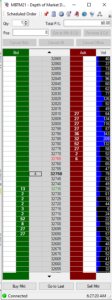When it comes down to a choice between trading a liquid versus an illiquid market, liquid markets are always the preference.
A liquid market means there are enough buyers and sellers in the room to make transactions more efficient, and less costly, as the spreads between the bid and the ask are often much narrower. That’s when you have a choice. Sometimes, you don’t.
The Dilemma of Trading an Illiquid Market
 Professional traders often face this dilemma, particularly money managers who have to trade illiquid instruments such as oats, rice, dairy, and lumber to satisfy the requirements of a particular fund, or to diversify the more commonly-traded components.
Professional traders often face this dilemma, particularly money managers who have to trade illiquid instruments such as oats, rice, dairy, and lumber to satisfy the requirements of a particular fund, or to diversify the more commonly-traded components.
You can also come across illiquid markets when you’re trading new products, like the recently-launched Micro Mini Bitcoin Futures, where the volume may be thin, and the spreads may be wide.
There’s More to It Than Meets the Eye
Illiquidity is all you see. It’s what’s on your trading screen. Low volume and wide spreads. You’re looking at the displayed liquidity.
What you don’t see is the hidden liquidity, and you won’t see it until a trade between the bid/ask spread takes place, establishing a new “last trade” and a new bid and ask. By then it’s too late. You missed the opportunity that you didn’t know you had.
To find the buyers and sellers behind the data and between the spreads, you have to be patient and methodically hunt for it. Here’s how.
Finding Liquidity That Seemingly Isn’t There
There is one cardinal rule when trying to seek out liquidity that’s hidden: never use a market order. Given the wideness of the spreads, a market order will likely give you wider-than-desired slippage, raising your trading costs.
Let’s suppose you see the following liquidity profile for hypothetical Asset X.
- Volume: 11
- Open Interest: 21
- Bid 0.70 – Ask 0.85
It’s hard to imagine a liquidity profile worse than this. You have virtually no volume, thin open interest, and a spread that’s 15 cents wide. It makes you wonder if there’s anyone in the room.
Finessing the Trade Has Everything to Do with Patience and Relative Speed
Let’s suppose you decide that 0.75 is an ideal entry point for a buy, and that any price above 0.80 is a little expensive. What might you do? The answer is place a limit order.
A limit order allows you to define a specific price as your absolute limit, It essentially says, “give it to me at this price or better.”
Think of the saying: buy low, sell high. Following this logic, the “or better” price for a buyer is lower, while for a seller, it’s higher.
This might take some time, but you would start bidding at 0.75. If no seller takes it, you move your limit order a tick higher, and you do so patiently.
Eventually, you would work your way up to the ask of 0.85, moving as quickly as you can before the price changes. But again, if it’s an illiquid market, price might not move that quickly.
So, there it is. No rocket science. Just patient and methodical legwork on your part. The hard part will be adjusting your order as you watch the flow of bids and offers fluctuate from one price to another as the last price bounces around.
If an illiquid asset is worth trading for one reason or another, it’s hard to come up with a better way to finesse the market than bidding for it carefully and patiently. It’s what some professional traders do, and it’s a skill that perhaps you too should develop.
Please be aware that the content of this blog is based upon the opinions and research of GFF Brokers and its staff and should not be treated as trade recommendations. There is a substantial risk of loss in trading futures, options and forex. Past performance is not necessarily indicative of future results.